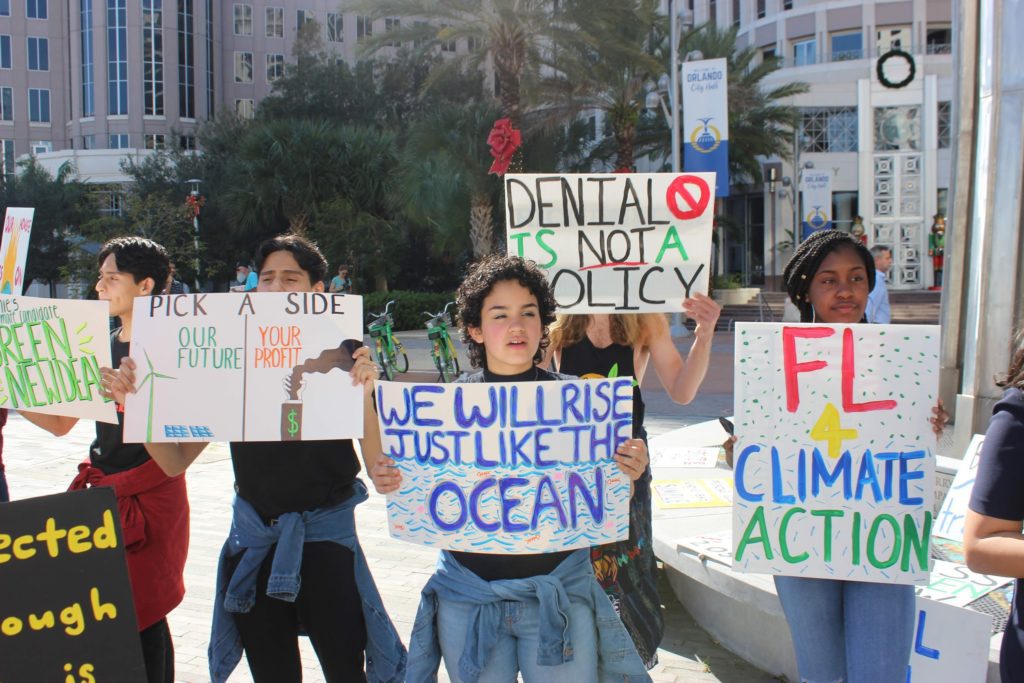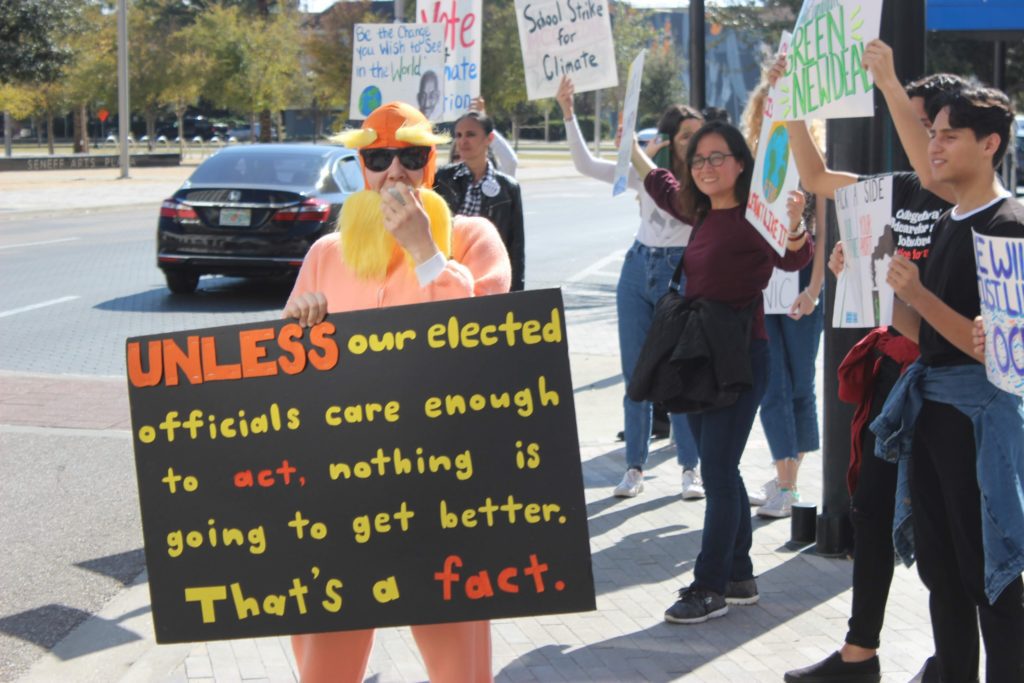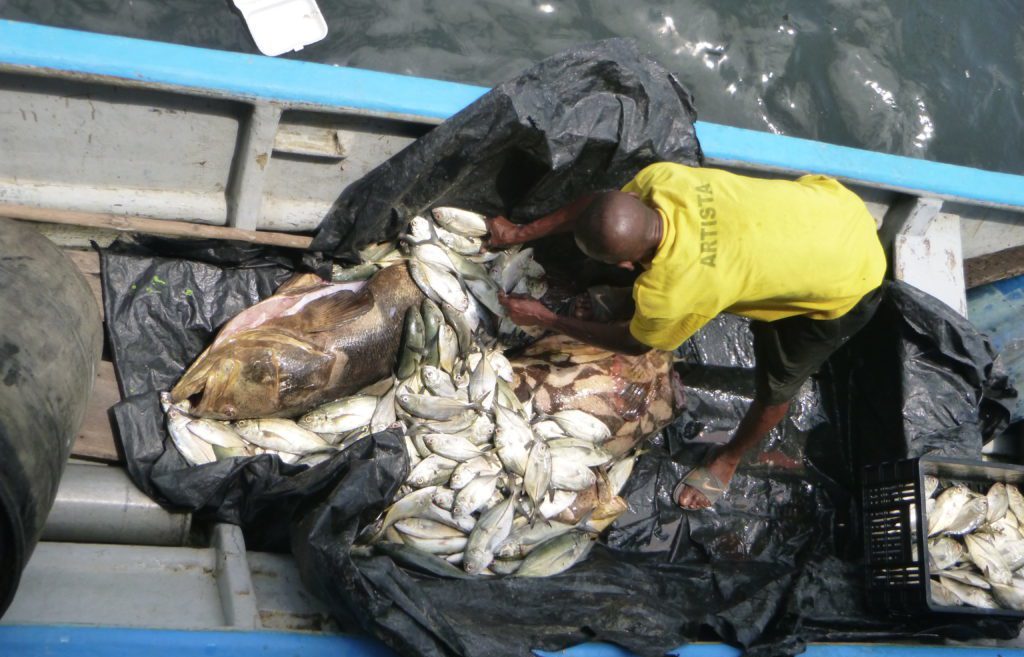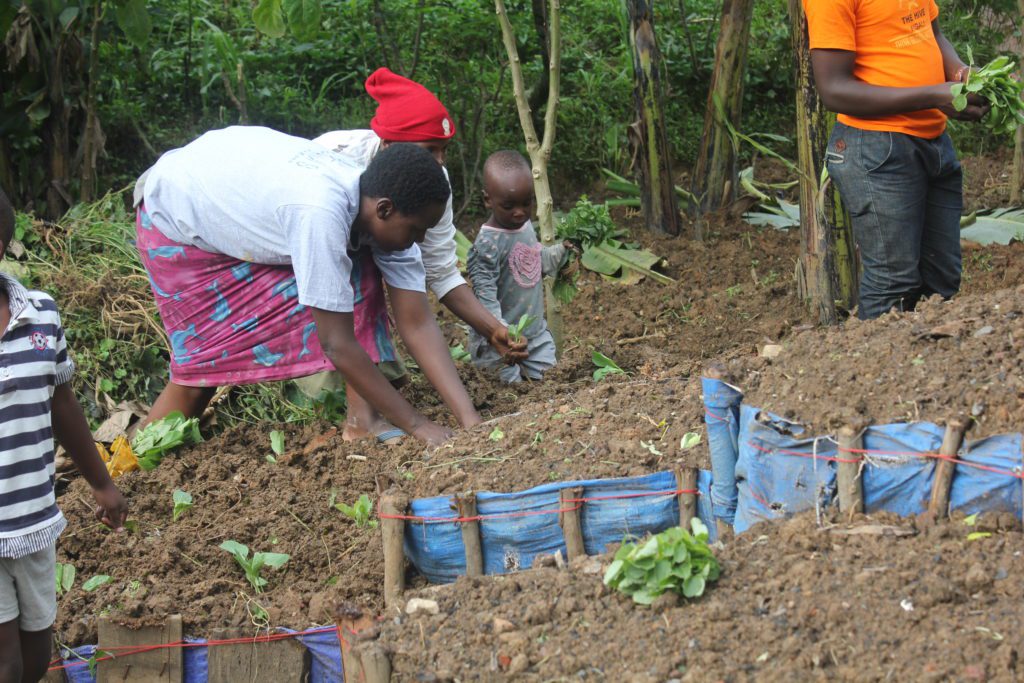Perched on the base of the Tower of Light sculpture, microphone in hand, Lorena Sosa, youth activist, addressed a small crowd of cheering protesters gathered outside Orlando City Hall. The planet is in big trouble, she told them. She added that adults are ignoring this simple fact. Sosa, who is 17 and a junior at Timber Creek High School in Orlando, Florida, spoke with an unstilted eloquence illustrative of so many youths today: poised, intelligent, worried about the future.
“How are high schoolers like me supposed to dream and reach for the stars when our leaders are withdrawing from any investments meant to protect our environment,” she said. Her face wore the careworn expression of someone far beyond her years. “At this point it is in our hands to spread the word about [climate change].”
On Dec.6, IDEAS For Us, an Orlando-based think tank dedicated to environmental sustainability, held its second Fridays For Future Global Climate Strike in downtown Orlando. The day was warm and breezy, the atmosphere calm and peaceful. Participants—a mix of old and young, all bedecked in various shades of green—held their signs skyward, their message clear. Humanity is running out of time. Climate change is happening. Now, those in power should take heed of the science, and of the youth activists trying to warn them, before it’s too late.
“These demonstrations send a public message to lawmakers that’s not behind closed doors,” said Ben Wilkin, 26, a bioengineer and marketing manager who also spoke at the event. “We’re not 10 people with a lot of money meeting with politicians in private; we’re 1,000 people with no money saying, ‘This is what you need to do.’ If you look at history, that’s the way big things that don’t have funding get funded—it’s through public will.”
The Dec. 6 strike saw significantly fewer protesters (roughly 40) than the one held in September, which drew close to 300 people. The group remained a powerful force, small yet loud, determined to put pressure on lawmakers for more climate-change regulations. Other speakers of the event that youth activists and others came to see included House Rep. Anna Eskamani, Raquel Fernandez of Sierra Club Florida and Laura Belts with East Orlando Coalition. One protester came dressed as Lorax, the titular character from a Dr. Seuss book about how greed supersedes a respect for nature—the enduring plight of the environment.
But the showstoppers of the strike were unquestionably the youth activists. Angry, frustrated, resolute—they demanded action from those tasked with safeguarding their future: parents, lawmakers, politicians, world leaders. In fact, the concern of many youth activists is not just awareness. More so, it’s implementing real change in environmental policies, in legislation, in state and municipal sustainability goals. It’s changing daily routines and habits. Without action, as hundreds of thousands of them have trumpeted in the streets, their efforts are meaningless.
Sosa, dressed in a fitted white shirt and high-rise blue jeans, a flourish of sparkly ivy painted on the right side of her face, concluded her speech, her voice carrying the urgency that the environmental crisis commands. “We have solutions to this problem,” she said. “Now let’s speak about them.”

Photo credit: Ernest Calderon
If the past few years serve as an indicator for the state of today’s youth, it’s that young people have come to apprehend the power behind collective voice. Exercising their right to free speech, taking to the streets—students no longer see their age as a barrier to fight injustice. It’s a cultural moment gone viral. Young people inspiring each other so that younger generations can have a safe place to grow up and live.
Take celebrity climate activist Greta Thunberg, the face of the Fridays for Future movement, who began her solo crusade in August 2018. Pint-sized but mighty, Thunberg, then 15, sat in silence outside the Swedish Parliament, sporting a blue hoodie and her trademark pigtails, holding a sign that read, in Swedish, “School Strike for Climate.” In the 16 months since, her message—that world leaders must take bolder action in reducing carbon emissions, the largest contributor to climate change—has influenced youth activists and their empowerment on a massive scale.
Thus far, more than seven million people worldwide have participated in climate strikes. And, at least for Thunberg, it all stems back to another group of influential youths: the students of Marjory Stoneman Douglas High School, who mounted a gun control protest, after a mass shooting at their school. Inspired by their emotive plea for stricter legislation, Thunberg saw the potential for change that peaceful activism could spur, even coming from a young person.
Several Fridays for Future demonstrations have also, not incidentally, coincided with major international climate summits. The most recent was on Dec. 6 during the U.N.’s 25th session of the Conference of the Parties, otherwise known as COP25. The two-week conference, held this time in Madrid, ended Sunday after an additional two days of deliberations. Leaders from nearly 200 countries introduced “ambitious new targets” for reducing greenhouse gases. Other topics discussed included streamlining the global carbon market, protecting forests, oceans and the poles as well as helping developing nations adapt to climate change by investing in low-carbon systems.
Though the conference focused largely on niceties, such as clarifying goals of the Paris Agreement, which aims to keep the world’s temperature from exceeding 1.5 degrees Celsius, it was still a critical step in paving the way for international diplomacy in upcoming U.N. negotiations. This was also the last major summit before next year’s COP. Set to take place in Glasgow, this will be where world leaders will finalize the commitments of the agreement. Scientists have maintained that keeping global temperature below 1.5 degrees Celsius would require halving global emissions by as early as 2030. Reports show a 4% increase in greenhouse gases since 2015, when the agreement was signed. The world, at large, is nowhere near meeting that target.
Making matters worse, COP25 ended without any significant resolutions. Among the many chasms between international parties was the unresolved issue of the conference’s supposed main objective: deciding on “enhanced ambitions” for reducing global carbon emissions. The result of the conference, after some finger pointing and a promise to resolve matters next time, was a draft text with watered down, evasive language and more loopholes for polluters than what was contained in the original Paris accord. In a press conference held on the last day of negotiations, analysts for climate advocacy groups called the text “disgraceful,” “shockingly weak,” “appalling,” “a betrayal.”
While some activists had higher hopes for COP25’s outcome, Thunberg, who attended the massive strike in Madrid on Dec. 6, foresaw disaster. Sounding exasperated and discouraged by political inaction, she delivered a pointed speech to a 500,000-strong march in Madrid’s city center: “We have been striking now for over a year and still, basically, nothing has happened,” she said. “The climate crisis is still being ignored by those in power and we cannot go on like this. It is not a sustainable solution that children skip school.”

Photo credit: Wikimedia Commons
Nonetheless, some students and youth activists, like Sosa, are more than prepared to do so—at least until lawmakers and elected officials start listening. The Dec. 6 strike in Orlando was Sosa’s second protest; in September, she attended the first Fridays For Future climate strike with IDEAS For Us, this one also held in front of City Hall. She had been looking to join a local protest, and happened upon the Fridays For Future Global Climate Strike on Facebook Events. Excitement about the youth climate movement was buzzing around her school’s halls. She felt compelled to participate.
But the seed to educate others about the dangers of pollution was planted long before then. Last year Sosa took an AP environmental science course. There she learned the “little things that make the most impact on the environment, as well as things not typically discussed in daily conversations, like deforestation, dirty oil money and mining,” she said.
Sosa’s friend Dawn Royster, who is 17, also took the class and participated in the December strike with her. They agree that the Florida Board of Education should mandate a required environmental course. Preferably, one that is accessible to all students, not just those taking college credits. “We’re required to take courses like U.S. government and macroeconomics,” Royster explained, “but teaching students how to alter their day-to-day lives to sustain life on this planet is seen as something extra, something people don’t have to learn right now.”
Because many adults have failed to recognize the scale of the climate crisis, or simply dismiss it, as they will unlikely witness the more extreme terracidal effects of it in their lifetime, youths bear the burden of educating one another. It’s the younger generations who employ sustainable alternatives to daily habits. It’s the younger generations who are going vegan, eschewing plastic bags and composting in their backyard. And it’s ultimately the youth activisists who will move the needle on saving the planet.
“Young people have the most to lose,” said Ben Wilkin, the bioengineer and one of the event’s speakers. “Their motivations are more pure. They don’t really have political ties yet or ties to certain industries. Their ties are to the next 50 years.”

Photo credit: Ernest Calderon
As global warming continues unabated, Florida will be one of the geographic regions that bear the brunt of its consequences. “Dangerous heat days,” as scientists call them, are expected to increase from 25 days a year to 130 by 2050. Extreme weather and flooding will lead tomosquito seasons will last longer. This heightens the risk of insect-borne diseases, such as West Nile virus, Eastern equine encephalitis and St. Louis encephalitis. Nearly half of the coral reefs that blanket Florida’s seaboard, known as the third-largest barrier reef in the world, have disappeared. This is due to ocean acidification from warming water temperatures. And the sea level around Florida is eight inches higher than it was in 1950.
Hoping to address these issues, protesters at the Dec. 6 strike came armed with a list of demands. Chief among them was passing legislation that would transition the state to 100% renewable energy by 2050 (HB97/SB256), designate sunscreens containing coral-bleaching chemicals as prescription-only (SB318), prohibit plastic carryout bags and straws (SB40), and ban shark finning and the sale of shark products (HB401/SB680). The Sunshine State has indeed made admirable strides in reducing its carbon footprint. Notably in its investments toward green buildings and renewable energy. It still has a long way to go in the battle against global warming.
After the last speaker concluded, protesters lined up in single file and marched through downtown Orlando. They held their signs held high, cheering every time a passing vehicle honked. With Lorax leading the way, they bellowed a series of chants: Do you know what would be great? Solar in the Sunshine State! What do we want? Climate action! When do we want it? Now!
Sosa and Royster trailed behind, texting and taking pictures with their phones. Punctuating their rallying cries were moments of camaraderie and laughter, the carefree joys of being a teenager. Attending the strike meant they both would receive an unexcused absence from school. No matter: These youth activists saw the ecological crisis at hand as more urgent than missing one or two days of classes. “I came today for my future,” Royster said. “I want to have kids one day and I want them to live on this planet and enjoy the same things that I have.”
Sosa hopes administrations will change school policies and excuse absences for those youth activists participating in Fridays for Future protests as more students support climate activism. “Civic responsibility is so important,” she said. “And that’s exactly what students are demonstrating with these strikes. We’re showing that we care, that our extensive life on Earth is more valuable than money. The first step to taking action is to show that you care.”
Join us on Earth Day to be part of Fridays For Future’s next global climate strike. RSVP here.

Sources:
https://time.com/person-of-the-year-2019-greta-thunberg/
https://unfccc.int/process-and-meetings/the-paris-agreement/what-is-the-paris-agreement
https://www.cnn.com/2019/11/29/world/global-climate-strikes-black-friday/index.html
https://www.activesustainability.com/climate-change/cop25-madrid-what-can-we-expect/
https://www.vox.com/2019/12/15/21022674/cop25-madrid-climate-change-greta-thunberg
https://unfccc.int/sites/default/files/english_paris_agreement.pdf
https://www.nationalobserver.com/2019/12/07/news/greta-thunberg-helps-lead-massive-protest-madrid
https://statesatrisk.org/florida/all
http://www.floridahealth.gov/diseases-and-conditions/mosquito-borne-diseases/index.html
https://www.environmentalpollutioncenters.org/news/coral-reef-decline-in-florida/



